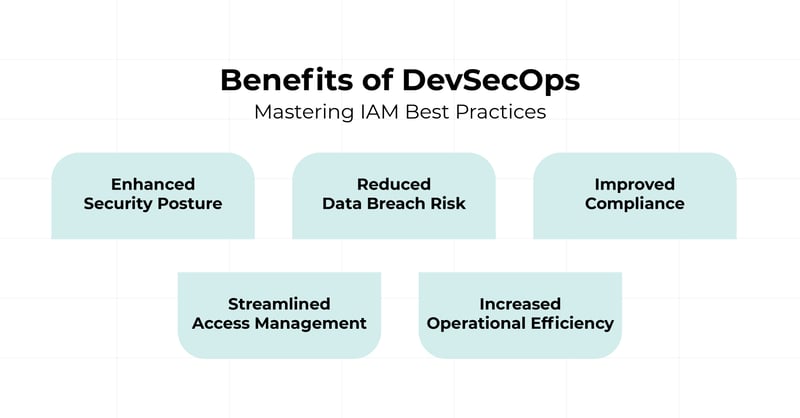Identity and Access Management (IAM) stands as one of the critical components of DevSecOps, tasked with safeguarding the digital fortress by ensuring that only authorized individuals can gain entry while swiftly detecting any unauthorized attempts. It also plays a vital role in enhancing security posture, reducing the risk of data breaches, and ensuring regulatory compliance.
 In today's fast-paced software development world, security has emerged as a pivotal paradigm that requires integration into every stage of the software development lifecycle (SDLC), from design to deployment. Integrating security practices has given rise to DevSecOps, a revolutionary approach that transcends traditional security measures by infusing security into every aspect of the SDLC.
In today's fast-paced software development world, security has emerged as a pivotal paradigm that requires integration into every stage of the software development lifecycle (SDLC), from design to deployment. Integrating security practices has given rise to DevSecOps, a revolutionary approach that transcends traditional security measures by infusing security into every aspect of the SDLC.
Building a Robust Security Architecture with DevSecOps IAM

-
Protecting Secrets: Safeguarding Your Credentials and Code Secrets
One of the critical components of IAM is protecting secrets, which involves safeguarding credentials and code secrets. Relying solely on detection is not enough; a strong security-focused culture and education can also mitigate risks. Utilize secret vaults and Multi-Factor Authentication (MFA) for added security. Despite these measures, human error remains a factor, necessitating tools like SpectralOps secret scanners to catch leaks before they occur. -
Using Outside Tools Wisely
Adding tools from outside sources can make managing IAM easier, but it’s not without risks. Using different clouds helps you manage notifications and keeps your IAM tools separate. Make sure the tools you add are safe. Even though open-source tools can be good, they also have risks. Check the security of any outside tool carefully. This helps you avoid problems and keeps your IAM system strong. -
Enhancing Security with Multi-Factor Authentication & Single Sign-On
Single Sign-On (SSO) simplifies user monitoring by providing centralized authorization for all resources, boosting security by reducing the likelihood of password compromises. MFA adds an extra layer of protection, preventing unauthorized access even if a password is leaked. It also promotes password privacy, as users are less likely to share their credentials when an additional authentication factor is required. Implementing SSO and MFA strengthens access control and enhances identity management. This approach increases confidence in identifying users, improving overall security posture. -
Securing Access with Least Privilege Control
Limiting access reduces the impact of breaches by minimizing the reach of compromised credentials. Strict access management helps control potential breach scopes, as not everyone requires access to all resources. IAM policies should align with the principle of least privilege, granting access based on necessity. This practice applies to all personnel, not just non-technical users, as developers often receive unrestricted access. Restricting developer access can enhance collaboration and product cohesion by encouraging interaction with domain experts. Such restrictions compel developers to seek expertise in areas they lack access to, fostering innovation. Implementing least-privilege access control strengthens overall security practices and reduces unauthorized access risks. -
Monitoring Throughout the SDLC
Continuous user activity monitoring is crucial for optimizing resource usage and identifying access needs. This practice allows for efficient license allocation and cost savings. It also helps enforce least privilege access control policies, enhancing cloud security. Updating access privileges based on changing user needs throughout the SDLC is essential. Implementing identity and access management best practices, such as limiting unnecessary access and enabling Multi-Factor Authentication (MFA) and Single Sign-On (SSO), can significantly reduce the risk of data breaches. Regular monitoring of user behavior and resource usage provides valuable insights for informed decision-making. Additionally, employing effective secret scanning tools helps prevent secrets from being leaked, mitigating the impact of human error, a common cause of access breaches.
Benefits of DevSecOps: Mastering IAM Best Practices
Embracing DevSecOps principles while mastering Identity and Access Management (IAM) best practices offers multifaceted advantages to organizations. This symbiotic approach ensures that security is not an afterthought but a fundamental aspect woven into every stage of the development process. By embedding security measures early on, it reduces the likelihood of vulnerabilities and breaches, thereby enhancing the overall security posture.

- Enhanced Security Posture: DevSecOps practices embed security throughout the development process, leading to a more secure environment.
- Reduced Data Breach Risk: Strong authentication, least privilege, and regular access reviews mitigate the risk of data breaches and unauthorized access.
- Improved Compliance: DevSecOps helps ensure adherence to relevant regulations.
- Streamlined Access Management: Automation simplifies access provisioning and de-provisioning, reducing errors and providing timely access changes.
- Increased Operational Efficiency: Implementing DevSecOps best practices for IAM significantly enhances operational efficiency and security posture.
IAM practices for DevSecOps have become essential to modern software development. Implementing the best practices discussed in this blog can help enhance the overall security posture, reduce the risk of data breaches, and ensure regulatory compliance. By embedding security into every aspect of the SDLC, we can build a robust digital fortress that can withstand any cyber threat.
Ready to strengthen your security posture? Our team offers expert DevSecOps IAM insights to help you achieve your goals. Contact us today to learn more!

